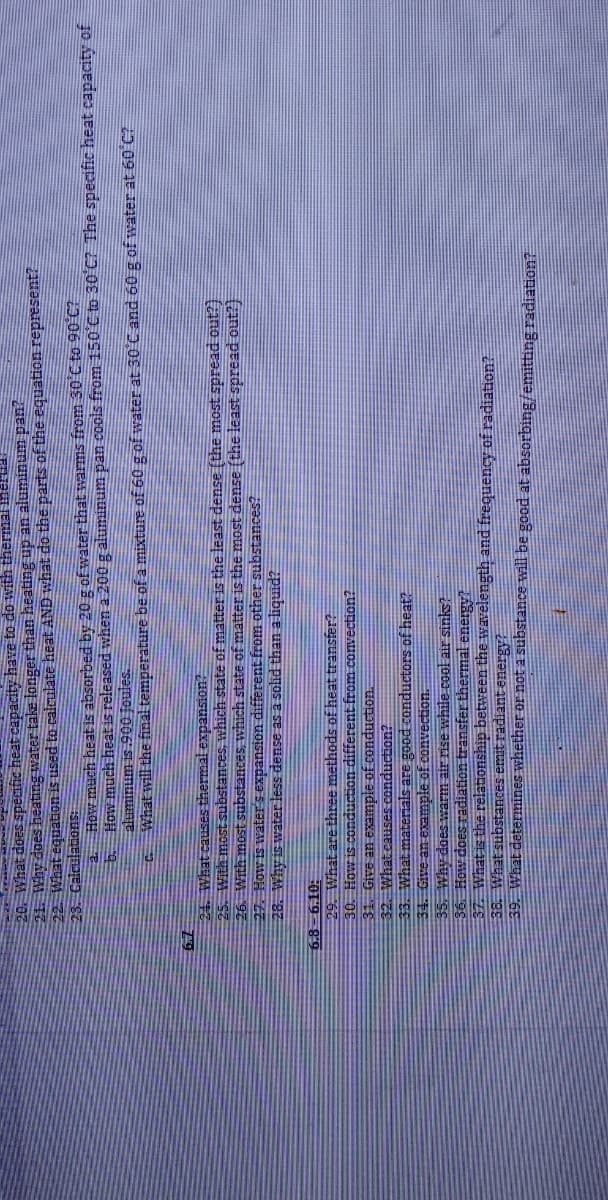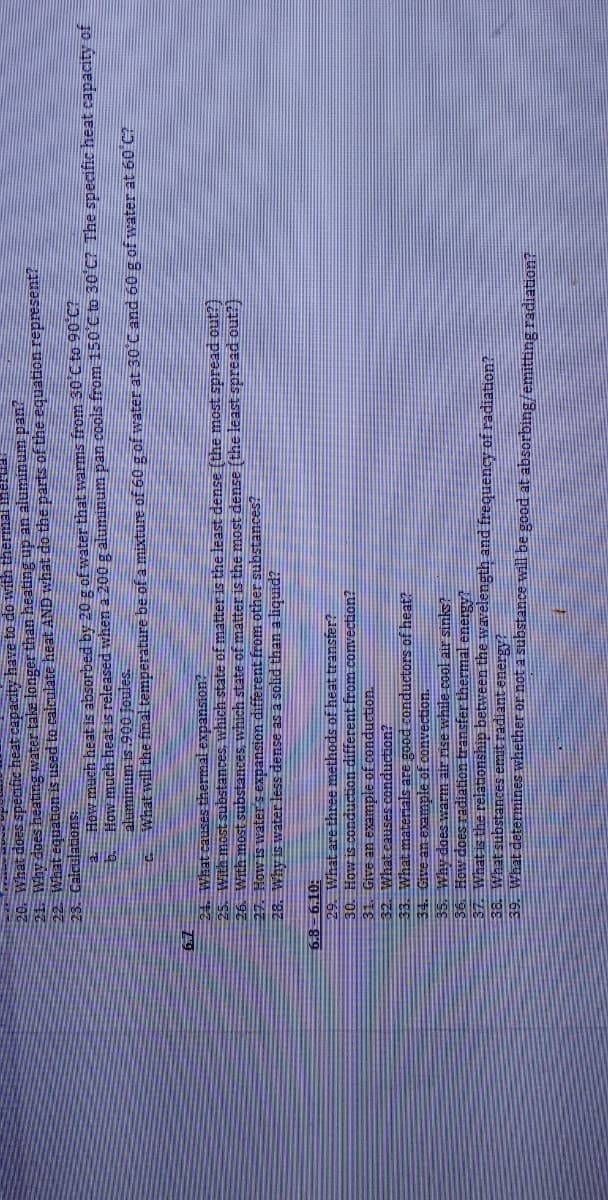pupads saop 1eUAI '07 22 What equation is used to calculate heat AND what do the parts of the equation represent? How much heat is released when a 200 g aluminum pan cools from 150°C to 30 C7 The specific heat capacity of What will the final temperature be of a mixture of 60 g of water at 30°C and 60 g of water at 60 C? 79 24. What causes thermal expansion? 25. With most substances, which state of matter is the least dense (the most spread out?) 26. With most substances, which state of matter is the most dense (the least spread out?) 27. How is water's expansion different from other substances? 28. Why is water less dense as a solid than a liquid? 6.8 – 6.10: 29. What are three methods of heat transfer? 30. How is conduction different from convection? 31. Give an example of conduction. 32-what eauses condurtion?
pupads saop 1eUAI '07 22 What equation is used to calculate heat AND what do the parts of the equation represent? How much heat is released when a 200 g aluminum pan cools from 150°C to 30 C7 The specific heat capacity of What will the final temperature be of a mixture of 60 g of water at 30°C and 60 g of water at 60 C? 79 24. What causes thermal expansion? 25. With most substances, which state of matter is the least dense (the most spread out?) 26. With most substances, which state of matter is the most dense (the least spread out?) 27. How is water's expansion different from other substances? 28. Why is water less dense as a solid than a liquid? 6.8 – 6.10: 29. What are three methods of heat transfer? 30. How is conduction different from convection? 31. Give an example of conduction. 32-what eauses condurtion?
College Physics
1st Edition
ISBN:9781938168000
Author:Paul Peter Urone, Roger Hinrichs
Publisher:Paul Peter Urone, Roger Hinrichs
Chapter14: Heat And Heat Transfer Methods
Section: Chapter Questions
Problem 73PE: Integrated Concepts Heat transfers from your lungs and breathing passages by evaporating water. (a)...
Related questions
Question
100%

Transcribed Image Text:20. What does specific heat capacity have to do with thermal meniaa
21. Why does heating water take longer than heating up an aluminum pan?
22 What equaton is used to calculate heat AND what do the parts of the equation represent?
23. Calculations:
a How much heat is absorbed by 20 g of water that warms from 30°C to 90 C?
How much heat is released when a 200 g aluminum pan cools from 150 C to 30 C7 The specific heat capacity of
aluminum is 900 Joules.
a What will the final temperature be of a mixture of 60 g of water at 30 C and 60 g of water at 60 C
79
24. What causSes thermal expansion?
25. With most substances, which state of matter is the least dense (the most spread out?)
26. With most substances, which state of matter is the most dense (the least spread out?)
27. How is water's expansion different from other substances?
28. Why is water less dense as a solid than a liquid?
OT9- 89
29. What are three methods of heat transfer?
30. How is conduction different from convection?
31. Give an example of conduction.
32. What causes conduction?
33. What materials are good conductors of heat?
34. Give an example of convection.
35. Why does warm air rise while cool air sinks
36. How does radiation transfer thermal energyt
37. What is the relationship between the wavelength and frequency of radiation?
38. What substances emit radiant energy?
39. What determines whether or not a substance will be good at absorbing/emitting radiation?

Transcribed Image Text:20. What does specific heat capacity have to do with thermal meniaa
21. Why does heating water take longer than heating up an aluminum pan?
22 What equaton is used to calculate heat AND what do the parts of the equation represent?
23. Calculations:
a How much heat is absorbed by 20 g of water that warms from 30°C to 90 C?
How much heat is released when a 200 g aluminum pan cools from 150 C to 30 C7 The specific heat capacity of
aluminum is 900 Joules.
a What will the final temperature be of a mixture of 60 g of water at 30 C and 60 g of water at 60 C
79
24. What causSes thermal expansion?
25. With most substances, which state of matter is the least dense (the most spread out?)
26. With most substances, which state of matter is the most dense (the least spread out?)
27. How is water's expansion different from other substances?
28. Why is water less dense as a solid than a liquid?
OT9- 89
29. What are three methods of heat transfer?
30. How is conduction different from convection?
31. Give an example of conduction.
32. What causes conduction?
33. What materials are good conductors of heat?
34. Give an example of convection.
35. Why does warm air rise while cool air sinks
36. How does radiation transfer thermal energyt
37. What is the relationship between the wavelength and frequency of radiation?
38. What substances emit radiant energy?
39. What determines whether or not a substance will be good at absorbing/emitting radiation?
Expert Solution
This question has been solved!
Explore an expertly crafted, step-by-step solution for a thorough understanding of key concepts.
Step by step
Solved in 3 steps

Knowledge Booster
Learn more about
Need a deep-dive on the concept behind this application? Look no further. Learn more about this topic, physics and related others by exploring similar questions and additional content below.Recommended textbooks for you

College Physics
Physics
ISBN:
9781938168000
Author:
Paul Peter Urone, Roger Hinrichs
Publisher:
OpenStax College


College Physics
Physics
ISBN:
9781305952300
Author:
Raymond A. Serway, Chris Vuille
Publisher:
Cengage Learning

College Physics
Physics
ISBN:
9781938168000
Author:
Paul Peter Urone, Roger Hinrichs
Publisher:
OpenStax College


College Physics
Physics
ISBN:
9781305952300
Author:
Raymond A. Serway, Chris Vuille
Publisher:
Cengage Learning

College Physics
Physics
ISBN:
9781285737027
Author:
Raymond A. Serway, Chris Vuille
Publisher:
Cengage Learning


Physics for Scientists and Engineers, Technology …
Physics
ISBN:
9781305116399
Author:
Raymond A. Serway, John W. Jewett
Publisher:
Cengage Learning